July 16, 2010
Air Date: July 16, 2010
FULL SHOW
SEGMENTS
Let the Oil Slinging Begin
/ Mitra TajView the page for this story
The Gulf oil spill isn't just a massive environmental and economic disaster; it's also providing an ongoing flow of material for political spinmeisters. Oil is washing up in political races from Florida to Missouri, and is sullying Republicans and Democrats alike. Host Jeff Young talks with Washington correspondent Mitra Taj about how both parties are playing the spill. (06:00)
The Need for Seaweed
View the page for this story
Sargassum seaweed is a critically important habitat for hundreds of marine species. The plant originates in the Gulf of Mexico and is carried by ocean currents to the Sargasso Sea off the eastern seaboard. University of South Alabama marine scientist Bob Shipp tells host Jeff Young that scientists are concerned that oil in the Gulf is killing the sargassum and other marine life. (06:00)
Magic Seeds & the Miracle Crop
/ Bruce GellermanView the page for this story
Brazil’s vast savannah has undergone the largest transformation of land in history. Modern science and shear luck have turned the region into a vast ocean of soybeans. Living on Earth’s Bruce Gellerman visited the central savannah to see if it’s environmentally sustainable. (18:20)
Science Note/ Spud Saboteur Turns Good
/ Amanda MartinezView the page for this story
The Guatemalan potato moth has long plagued tuber crops in South America. But as Living on Earth’s Amanda Martinez reports, scientists recently found that a compound in the moths’ saliva can actually more than double potato yields. (01:30)
The Other Oil Spill
View the page for this story
You may have heard of the plastic trash vortex in the North Pacific Ocean. It’s a region where wind and ocean currents cause plastic to accumulate by the ton. But it turns out that the North Pacific isn’t the only ocean with a plastic problem. Host Jeff Young talks with Giora Proskurowski, an oceanographer with the Sea Education Association, about his recent exploration of the plastic vortex in the North Atlantic. (05:30)
Self-reconfiguring Robots
/ Glen ZorpetteView the page for this story
Imagine a robot made of small cubes that can join together and change their shape and behavior without human input. A group of MIT researchers have designed these Lego-sized cubes that are programmed to connect and communicate with each other. As Glen Zorpette reports for the IEEE Spectrum Magazine and National Science Foundation series, “Robots for Real,” self-configuring smart robots could have an impact on everyday life. (05:00)
The Message Remixed
/ Ike SriskandarajahView the page for this story
From anthems about clean energy to ballads on fresh fruit, a number of hip hop’s socially conscious artists are on a green streak. Living on Earth and Planet Harmony’s Ike Sriskandarajah explores the greening of hip hop. (04:55)
Show Credits and Funders
Show Transcript
HOST: Jeff Young
GUESTS: Bob Skipp, Giora Proskorowski, Glenn Zorpette, Dan Gerstein
REPORTERS: Mitra Taj, Bruce Gellerman, Ike Sriskandarajah
SCIENCE NOTE: Amanda Martinez
EARTH EAR: Lang Elliott
[THEME]
YOUNG: From Public Radio International - this is Living on Earth. I’m Jeff Young. The oil in the Gulf threatens an entire floating ecosystem…the tiny but vital creatures riding the currents on mats of Sargassum weed.
SHIPP: Sargassum almost acts like a sponge. It just soaks up the oil. And the sargassum is relatively delicate, once the oil hits it, it will essentially suffocate the sargassum and it will kill it.
YOUNG: The web of life depending on this seaweed may be dying too. And we travel to Soylandia----the cerrado of Brazil -where the tropical savannah has been transformed into fields of Soy.
WARNKEN: Several things happened and they all came together as what one can call a positive perfect storm. And from then on soybeans swept across the cerrado like wildfire.
YOUNG: What soy’s success means for Brazil’s forests. Those stories and more this week on Living on Earth - stick around!
[THEME]
Let the Oil Slinging Begin
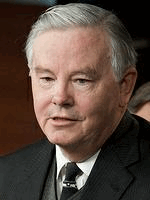
Congressman Joe Barton (R-Texas) delivered the apology that launched a thousand condemnations-- and boosted a few Democratic campaigns. (Courtesy of Republican Conference)
YOUNG: From the Jennifer and Ted Stanley studios in Somerville MA this is Living on Earth. I’m Jeff Young. Well, BP might finally have a handle on the flow of oil into the Gulf, but that hasn’t kept the oil from spilling over into politics. Mid term elections are approaching…Control of Congress is on the line… and the oil disaster is quickly becoming a campaign issue, thanks partly to this one moment:
BARTON: I apologize.
YOUNG: When Texas Republican Congressman Joe Barton apologized to BP CEO Tony Hayward for the administration’s efforts to make the company pay for damages. Democrats quickly seized the political moment. And now, where we once had mud slinging in elections, we have oil slinging. Living On Earth’s Mitra Taj is on Capitol Hill tracking how the spill is being spun in the campaigns. Hello Mitra!
TAJ: Hi Jeff!
YOUNG: In what races do you see this issue coming up?
TAJ: Well, it’s been interesting. You’d expect the spill to be a big issue in Gulf states like Louisiana… where Republican Senator David Vitter is being accused of being too friendly with the oil industry…or in Florida… where Governor Charlie Crist recently changed his mind and is opposing offshore drilling in his run for the Senate… But the oil spill is surfacing even in races hundreds of miles from the Gulf Coast.
YOUNG: Like where?
TAJ: Well, Pennsylvania, Kentucky, Missouri… Democrats are trying hard to paint the Republican Party as representing oil interests, and some have taken to calling the GOP the BOP, or Big Oil Party.
YOUNG: Uh huh, and I saw the Democratic National Committee has this new website they call BP Republicans.
TAJ: Right, and Joe Barton’s apology to Tony Hayward is still a favorite target for Democrats. This is President Obama invoking it at a campaign event in Missouri.
OBAMA: Noooo. He didn’t say that. But he did. Because they don’t think in terms of representing ordinary folks, that’s not their orientation. So, that’s the choice that we face in this election.
YOUNG: So, the president is clearly trying to get some mileage out of that. Who was he campaigning for there?
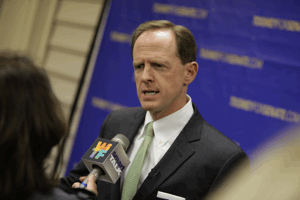
In Pennsylvania, the Democratic Senate candidate has attacked his Republican opponent Pat Toomey's support for oil drilling in the Great Lakes and his lack of criticism of Congressman Joe Barton. (Courtesy of Pat Toomey)
TAJ: That was a stump speech for Democrat Robin Carnahan. She’s up against Congressman Roy Blunt for the Missouri Senate seat.
[SCARY CAMPAIGN AD MUSIC]
And she’s launched some controversial ads against him…
[SCARY MUSIC UP]
YOUNG: Whoa, that sounds creepy.
[MUSIC FADES]
TAJ: Yeah, the ad mimics the post-apocalyptic horror movie “28 Days Later…” and you see images of the Deepwater Horizon explosion, the cleanup, and catch glimpses of her Republican opponent making a speech, which kind of leaves viewers with the impression that he doesn’t want BP to pay for the spill….
YOUNG: And is that accurate charge against Congressman Blunt?
TAJ: No. The website FactCheck dot org concluded that it doesn’t represent his views at all, but Carnahan’s campaign still points to Blunt’s campaign contributions from oil and gas. In the past year those added up to $130 thousand dollars, more than any other member of the House Energy committee. Even more than Barton.
YOUNG: So, that’s what the Democrats are doing with this. How are Republicans handling the spill?
TAJ: Well, they do like to point out that candidate Obama took more money from BP than any other candidate last time around. And they want to talk about oil too- they just want to tell a different story with it. They say the administration hasn’t done enough to respond to the spill. The Republican National Committee recently came out with an oil spill website of its own: “Play Golf or Save the Gulf.” If you go to it you see a picture of the president on a golf course, and you’re invited to build your own top five lists of reasons why you should be angry with the president…
YOUNG: And, are Republican candidates picking up on those talking points?
TAJ: Yeah. In Florida, the Republican’s pick for Senate, Marco Rubio, was recently quoted saying the administration is guilty of “insanity” and “incompetence” in responding to the oil spill. And, many Republicans have tried to distance themselves from Representative Barton’s apology, but others are still openly critical of the pressure the administration has been putting on BP. Like in Kentucky, Republican Senate candidate Rand Paul said it’s “un-American,” and Former Speaker of the House Newt Gingrich had this to say as he was campaigning for Congressional Candidate Brad Zaun in Iowa:
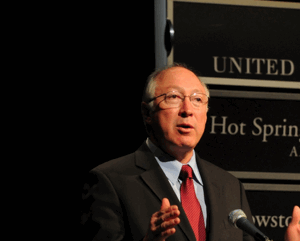
Former House Speaker Newt Gingrich said he would fire Interior Secretary Ken Salazar for saying he'll put his boot on the neck of BP until the spill is cleaned up. (Courtesy of Department of Interior)
GINGRICH: When the Secretary of the Interior said that they are going to put their boot on the neck of BP, I frankly thought he should be forced to resign that day… because Americans [applause]. Any government official who believes they can put their boot on one neck believes they can put their boot on your neck, and that is fundamentally antithetical to the American model.
YOUNG: Hmm. So what do you think, Mitra, is any of this gaining traction with voters? Is this going to make a difference in the mid-term elections?
TAJ: You know, it’s really hard to say. I think a lot depends on just how the cleanup goes and whether or not this will still be making headlines when elections really get started in the fall. I called up political strategist Dan Gerstein to see what he thinks. He worked on Joe Lieberman’s successful Senate run as Independent in 2006.
GERSTEIN: I don’t think it’s a win for anyone in large part just because no one has looked good. The government has not responded well, at least that’s the way the public perceives it, and there’s no vindication certainly for the Republican anti-regulatory, anti governmental mode these days.
TAJ: Gerstein says that the spill probably won’t be a game changer in politics or policy. But I think, clearly, Democrats want to make Republican ties to oil money toxic, and I think Republicans are trying hard show that the Obama administration came up short in its response to the spill. So, it will be interesting to see what actually happens in November.
YOUNG: Mitra Taj, thanks very much.
TAJ: Thank you Jeff.
Related links:
- Click here to watch Robin Carnahan's campaign ads on Roy Blunt's oil position.
- Read FactCheck.org's assesment of the advertisements.
- Check out the RNC's Golf or Gulf page.
- DNC's BP Republican site
-
[MUSIC]: Steely Dan “Royal Scam” from Royal Scam (UMG Records 1976).
The Need for Seaweed
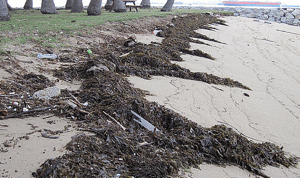
Beaches full of washed up sargassum are a common sight in many coastal areas. (wildsingapore)
YOUNG: The Sargasso Sea is fixed in nautical lore—it’s that patch of calm water near the Caribbean where sargassum seaweed collects in vast mats. But most of the sargassum of the Sargasso Sea really comes from the Gulf of Mexico, where the brown algae with little pea sized air pockets grows like crazy. And it’s there in the Gulf that marine scientist Bob Shipp is anxiously monitoring the sargassum weed that is now mixed with BP’s oil. Professor Shipp teaches at the University of South Alabama where he studies how the sargassum supports an entire ecosystem.
SHIPP: The Gulf has the second largest concentration of sargassum of any ocean in the world. A fair amount of it washes out through the straights of Florida on the Gulf Stream and ends up in the Sargasso Sea in the Atlantic Ocean off the East Coast of the United States.

The Sargasso Sea is not a sea at all but a calm area where several ocean currents come together to trap sargassum seaweed in huge dense mats 2,000 miles long. (http://www.Iliketolearn.com)
YOUNG: What is it about the Gulf that makes it produce so much of this stuff?
SHIPP: One has to speculate it’s just the environment, it’s just a combination of high salinity, clear water, and yet enough nutrients in the water to support the proliferation of the Sargassum. It’s just the ideal condition for it. At least until the oil hit.
YOUNG: So what does this mean if the oil is now mixed in with the sargassum?
SHIPP: Well, it’s unfortunate because sargassum almost acts like a sponge, it just soaks up the oil, and the sargassum is relatively delicate. Once the oil hits it, it’ll block out sunlight, it’ll essentially suffocate the sargassum and it will kill it. And when it does it kills all the biota, all the life, that is dependent on the sargassum- and there is a lot of that.
YOUNG: Well, tell me about the other species in the Gulf that depend on sargassum.
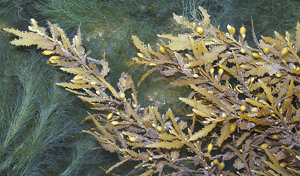
The Genus name sargassum comes from a Portuguese grape. Early explorers thought the round floats on the seaweed looked like the grapes they knew from home. (Photo: wildsingapore)
SHIPP: I think the best analogy is to think of the sargassum the same way one would think of marshes and sea grasses in estuaries. The sargassum is a major, major habitat. It provides cover for literally hundreds of species, not just fin-fishes, but crustaceans and other organisms as well. If you run a camera up under sargassum you just see a plethora of different species.
One of my colleagues recently sampled some sargassum and a whole vial full of larval blue fin tuna came out. So, many species lay their eggs on sargassum, many species depend on it for forage, for cover, especially in their early life phases. The highly migratory species like the tunas and the billfish and the dolphin fish, they all depend on that sargassum the same way that, near-shore, our blue crabs and flounders depend on sea grasses.
YOUNG: What’s the likely impact on those species that depend on this little floating ecosystem?
SHIPP: They’re totally dependent on it. If the sargassum goes, they go. Now fortunately, only about a third of the gulf has been impacted by the oil, so, there are vast areas of sargassum that are untouched in the Gulf. But, for those areas that have the sargassum covered with oil, it’s going to take quite a long time for the other areas of sargassum to come back and replenish those areas of the Gulf that have lost their sargassum. Unfortunately, species like the blue fin tuna for example, they don’t spawn gulf-wide, they spawn in very selected areas and so, the sargassum that is lost is also going to cause the loss of that whole year-class of blue fin tuna, and other species as well.

Beaches full of washed up sargassum are a common sight in many coastal areas. (Photo: wildsingapore)
YOUNG: How did you end up studying this weed anyway?
SHIPP: [laughs] Those of us who are fisheries biologists are well aware of how important the sargassum is. As soon as this spill became public, one of the first things we did was send vessels out sampling the sargassum that has not been impacted so we have a baseline. We wanted to quantify the populations in the un-impacted sargassum so when it did become impacted we could make those comparisons.
YOUNG: And, what have you been able to quantify thus far by way of impact, comparing it to the baseline data you collected? What do we know about just how bad it is?
SHIPP: Well, we’ve taken a number of sargassum samples that do have the oil in it. Most of the species are absent if the sargassum has oil. Some of the other species are confusing the oil globs for sargassum and they’re tying to hide in the oil globs, which of course renders them fatal in the long run. We don’t have real strong numbers right yet, but we will when this is all said and done.
YOUNG: Are there parallels in earlier spills or oil incidents that might give us some indication as to what to expect by way of impact here?
SHIPP: Well, you know, the first one thinks about is Valdez, and these many years later, 20-some years later, several species have never recovered in the Valdez area because of the impact on the habitat. The sardines, for example, the pacific sardines, which are dependent on vegetation in Valdez, never recovered, they never came back because that habitat never came back. I think the parallel here is with the sargassum. It will eventually come back, and when it does, these species will probably recover as well, but it’s not going to happen overnight, it’s not going to happen next year. It’s going to take a number of years for it to recover.
YOUNG: Professor Bob Shipp at University of South Alabama, thank you very much!
SHIPP: Oh, you’re most welcome. I appreciate you having me on.
Related links:
- Click Here to see a Clip of Sea Life that Lives Under Sargassum
- Bob Shipp’s Guide to Fishes of the Gulf of Mexico
[MUSIC]: The Basic “Milk” from Soul Freedom: the Best Of Jazzman 45’s (Jazzman/Kudos records 2009).
YOUNG: Just ahead - converting Brazil's savanna scrubland into the most productive soy fields on Earth.
WARNKEN: It was a wasteland. It was a giant wasteland and the conclusion was the cerrado had no future for commercial agriculture. That was in the mid '60s.
YOUNG: The unexpected bonanza...and unanticipated consequences of soy farming in Brazil. Keep listening to Living on Earth!
[CUTAWAY MUSIC]: “Chovendo na Roseira” from Afro Bossa Nova (Quitanda Music 2005).
Magic Seeds & the Miracle Crop
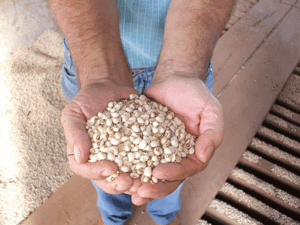
The transformation of Brazil scrub savannah into endless fields of soy is unprecedented. (Photo: Bruce Gellerman)
YOUNG: It’s Living on Earth, I’m Jeff Young. Agriculture experts call the soybean ‘a miracle crop.’ It’s used in thousands of products from tofu to bio-fuels. Most, goes to feed farm animals. The United States is the number one grower, but not for long. The soybean is booming in Brazil, where this year’s harvest was a record breaker. Market analysts expect Brazil will soon be the world’s leading producer. Just two generations ago, soybean farming on this scale in Brazil was unthinkable. Now, critics wonder if it’s unsustainable. Living on Earth’s Bruce Gellerman traveled to ‘ground zero’ of Brazil’s soy-revolution to find out.
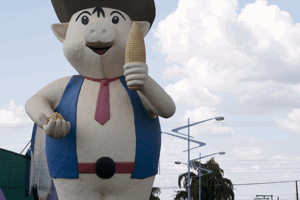
Porking out on Soy and Corn- A road side attraction in Mato Grosso. 85 percent of the world’s soy is used to feed farm animals. (Photo: Lauren Oakes)
[ROAD SOUNDS]
GELLERMAN: Mato Grosso is twice as large as California ….but there are only about half a dozen paved 2 lane highways in the entire state. Most roads are dark red dirt and deeply rutted… like this one, carved from the plateau frontier in the center of Brazil. This cerrado country.
[ROAD SFX]
GELLERMAN: In Portuguese ‘cerrado’ means “inaccessible” or “closed”…
LIMA: Here we have a typical cerrado vegetation, which is kind of a scrubland.
GELLERMAN: Biologist Marco Lima serves as guide and driver as we travel through this remote, rugged region.
LIMA: And you travel the next, at least, 12 hundred miles going north that’s the vegetation you’re going to find…
GELLERMAN: The cerrado is a tropical savanna - a complex mosaic of vegetation: closed canopy forests, vast grasslands and stunted, twisted trees…
[BIRDS, WATER]
GELLERMAN: But looks are deceiving… biologically, Brazil’s cerrado scrubland is the richest savanna on the planet…and, today, one of the most threatened. The ecosystem is home to ten thousand species of plants…half found only here. There are 200 species of mammals…and the place is a birder’s paradise…filled with macaws, parakeets, and vultures.
[BOATS ON WATER]
GELLERMAN: …and in the many Amazon River tributaries, marine life of all fin and stripe---peacock bass, pink river dolphins, and piranha. Half the year the forest’s torrential rains turn Mato Grosso’s dirt roads into red rivers of mud – the rest of the year, the land bakes in the tropical sun.
WARNKEN: The cerrado in its native state is extremely hostile
GELLERMAN: Phil Warnken literally wrote the book about farming in the cerrado. “The Development and Growth of Brazil’s Soybean Industry” is an oft-cited classic. Born and raised on a Kansas farm, Warnken was one of the first to investigate whether the ancient cerrado could be converted from scrub savannah into cropland.
WARNKEN: It was a wasteland, it was a giant wasteland…I first lived in Brazil in the mid 60’s… and was part of the study of the future potential of the cerrado. The conclusion of that team that was supported by the Rockefeller foundation…a first class blue ribbon team… the conclusion was that the cerrado had no potential for commercial agriculture. That was the mid 60’s.
[SOY TRUCKS ZOOM PAST]
GELLERMAN: Today, the sound of the BR 163 tells a different story.
[SOY TRUCKS ZOOM PAST]
GELLERMAN: The BR 163 – is better known as Brazil’s Soybean Highway. The two-lane road runs from Cuiabá- the capitol city in the center of Mato Gross 12-hundred miles north to a port on the Amazon. Much of the road is unpaved…and often impassable…but here its been surfaced,
LIMA: Trucks, trucks and Trucks.
GELLERMAN: Boy… they’re like mosquitoes you know…buzzzz
[SOY TRUCKS ZOOM PAST]
GELLERMAN: During the soybean harvest season 9 thousand trucks a day ---one every 6 seconds--- pass here, hauling soy from Brazil’s breadbasket to a world with a growing appetite for the oil and protein rich bean. Since 1985 global demand for soy has doubled and farmers in Mato Grosso have more than kept pace…soy output here has quadrupled.
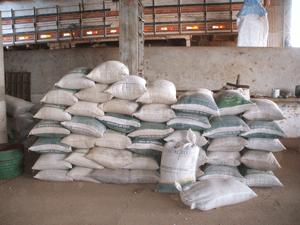
Sacks of Cerrado Soy- (Photo: Bobby Bascomb)
[TRUCK ZOOMS]
GELLERMAN: In less than 40 years Mato Grosso has undergone an agricultural revolution…the likes of which the world has never seen. The remote cerrado- once considered an agricultural wasteland- has been converted from scrub savanna into a vast ocean of soy, corn and cotton. It’s the result of a remarkable convergence of scientific breakthroughs, and shear luck. Again, soy expert Phil Wangren:
WANGREN: Several things happened and they all came together as what, I guess, one could call a positive perfect storm. And from then on, soybeans swept across the cerrado like wildfire.
GELLERMAN: The first thing that had to happen in order to grow the miracle soybean crop in this tropical climate was the development of what you might call a magic seed. For decades Brazilian and American scientists crossbred generations of soy plants before finally creating a seed that could thrive in the hot savanna. But the new seed also needed the right soil…the ancient cerrado soil is deep, which is great for soybean roots but over the ages torrential rains have worn and weathered the landscape.
WANGREN: Over the 50 million years, all of the soluble nutrients like nitrogen, calcium, magnesium have long, long ago been washed to the sea.
GELLERMAN: The cerrado soil was too acidic and loaded with toxic aluminum. And even the new soy seed couldn’t root in the poor soil. But then –says Phil Wangren, Brazil hit pay dirt.
WANGREN: There’s just unlimited limestone… it (laughs) would last for an eternity.
GELLERMAN: Miners found vast deposits of acid-neutralizing limestone….
[LIMESTONE …DRIVING BREAK….]
GELLERMAN: Conveniently located-- right in the middle of Mato Grosso.
[DOOR CLOSING, WIND]
GELLERMAN: Ooh it is dusty…look at that…the dust has covered…looks like snow!
[WIND]

Limestone dust swirls as Marco and Bruce talk with mine manager Eugenio Kestingee. (Photo: Bobby Bascomb)
GELLERMAN: The wind, white and powdery- swirls at an open pit mine near the town of Cáceres- where a mountain of limestone was found on a hillside.
[MAN SPEAKING PORTUGUESE]
TRANSLATOR: This is the primary system.
GELLERMAN: Eugenio Kestingee, production manager of the mine…shows off the machinery:
[MAN SPEAKING PORTUGUESE]
TRANSLATOR: This is where we crush the stones.
GELLERMAN: Workers mine 800 tons of limestone a day here. At 10 dollars a ton, “It’s cheap,” says the manager.
[MAN SPEAKING PORTUGUESE]
TRANSLATOR: Yeah, here in the state of Mato Grosso, without the help of limestone, you wouldn’t be seeing so much agricultural production around.
[SOUNDS FROM OPEN AIR MINE]
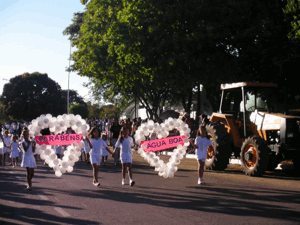
Everyone loves a parade as the the cerrado city celebrates its founding. (Photo: Bruce Gellerman)
GELLERMAN: Limestone turned the nutritionally poor land into soil suited for soybean. The discovery transformed the Cerrado, Mato Grosso, and Phil Wangren. He founded AgBrazil- advising investors from around the world interested in putting down roots in the dirt-cheap cerrado…. in what’s become know as “Soylandia.” Land speculators, squatters and settlers, also rushed in.
[AGUA BOA PARADE MUSIC]
GELLERMAN: Marching bands commemorate the founding of the city of Agua Boa, Mato Grosso. 30 years ago this was a frontier backwater - the entire county had a thousand people -today, the population has exploded 25-fold. Agua Boa-is a prosperous city boasting paved roads on the cutting edge of Brazil’s future. The mayor, Mauricio Tonha, says setters cleared the land of native vegetation and forests.
[MAN SPEAKING PORTUGUESE]
TRANSLATOR: Years ago, we slashed and burned the land. It wasn’t a lack of environmental concern. It was just the way things were done. We had no environmental guidance from the government.
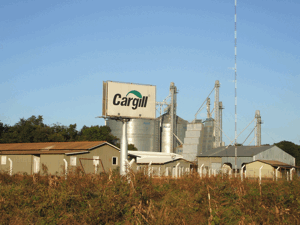
Cargil, MacDonalds and ADM are among the companies agreeing not to buy soy from deforested land in the Amazon. (Photo: Bruce Gellerman)
GELLERMAN: Brazil has some of the toughest environmental laws in the world but in this vast frontier, enforcement is weak…so non-governmental organizations have helped fill the void. Greenpeace recently renegotiated a 4-year-old moratorium with international soybean traders—who agree not to buy soybeans from newly deforested land in the Amazon. The deal has largely worked there. However, just south in the cerrado, deforestation has slowed, but continues. Nearly half-a million square miles of Mato Grosso’s cerrado have been slashed and burned.
[TRUCK SOUNDS]
CARTER: All this burned over here…see it’s all dead.
GELLERMAN: John Carter is head of an NGO that helps soy farmers preserve their forests while increasing profits. He drives us around his ranch in the remote northeast corner of Mato Grosso.

Texan John Carter staked his claim in Brazil’s cerrado frontier. (Photo: Bruce Gellerman)
CARTER: The fire blew through here, all that’s our forest reserve, it’s hard to tell from here- but that burned as well.
GELLERMAN: Carter is a transplanted Texan who came to the cerrado in the 1990’s seeking his fate and fortune. He was astonished at what he found.
CARTER: Fires in the U.S. you see on TV they’re a thousand acres and the world is screaming… and here we have hundreds of thousands of acres burning and no one says peep.
GELLERMAN: Scientists say the industrial scale slashing and burning of the region has released trillions of tons of forest carbon into the atmosphere and disrupted the region’s rain cycle…the cerrado is drying. Grassland fires that once could be contained now burn out of control. That’s why Carter, like other cerrado farmers is required by law to keep half his forest as reserve – so he’s re-growing 22 hundred acres of forest that burned down.
CARTER: This is five kilometers or three miles of straight lines that a tractor could drive to plant soybeans here. I let come back into compliance with the forest code, and that represents around 1.1 million dollars I threw away.

Scientists say industrial soy farming is changing the savanna climate and deforesting the landscape. (Photo: Bruce Gellerman)
GELLERMAN: Carter hopes to change the equation. His NGO Alianca da Terra shows farmers how to derive economic value from their standing forests. The Land Alliance helps farmers turn the carbon stored in their trees into credits companies can buy to offset their greenhouse gas emissions. Carlito Guimariz is a new member of Carter’s Land Alliance.
[GUIMARIZ UNFOLDING MAP]
[MAN SPEAKING PORTUGUESE]
TRANSLATOR: This is the county…
GELLERMAN: In these parts – Guimariz is known as the forest destroyer.
[MAN SPEAKING PORTUGUESE]
GELLERMAN: He opens a map…and points to his land…200 thousand acres… just south of the Amazon…on the Fontura River.
[MAN SPEAKING PORTUGUESE]
TRANSLATOR: I am on the Fontura River.
[MAN SPEAKING PORTUGUESE]
TRANSLATOR: That’s an area that was heavily deforested.
GELLERMAN: “The Forest Destroyer” says his reputation is well deserved --- he cleared and cut down a hundred thousand acres…and he makes no apologies.
BRUCE: I’m going to ask a not polite question… did you contribute to that deforestation.
[MAN SPEAKING PORTUGUESE]
TRANSLATOR: I did something conscience of what I was doing.
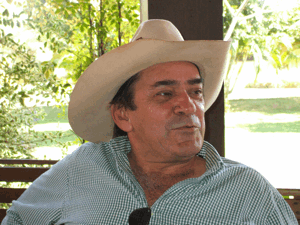
The Forest Destroyer- Carllito Guimariz. (Photo: Bruce Gellerman)
GELLERMAN: The forest destroyer now wants to be paid for keeping his remaining trees standing. There are no free lunches, he says… or breakfasts …or dinners…
[MAN SPEAKING PORTUGUESE]
TRANSLATOR: You see our world does not live without food. We could raise our productivity 3 or 4 times more…but, the thing is, will mankind be able to pay this price?
GELLERMAN: Cerrado farmers can boost their productivity, preserve their forests, and prevent green house gas emission…but the price is expensive. Intensive agricultural techniques and advanced technologies don’t come cheap and often there are steep, unintended, environmental costs and consequences.
[MAN SPEAKING PORTUGUESE]
TRANSLATOR: I have to show you this. This was sent me by John.
GELLERMAN: Farmer Jamar Bruenier is also a member of John Carter’s Aliance da Terra. The Alliance sent Bruenier a detailed report showing him how he can save bigbucks, or Brazilian reals, on expensive fertilizer.
[MAN SPEAKING PORTUGUESE]
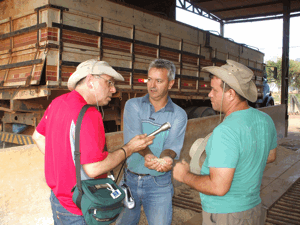
A Farmer Feeds the World- Soy farmer Jamar Bruenier being interviewed at his grain dryer. (Photo: Bobby Bascomb)
TRANSLATOR: Here you can see what is agriculture with precision…. This will show us the needs of the ground…per hectare…for example you can see the lack of potassium in this area which is the poorest area…Now we‘re putting the right doses that the ground needs and whatever there’s no need, we don’t put anything.
[WALKING TO GRAINERY SOUNDS]
GELLERMAN: To economize on fertilizer, prevent erosion and keep carbon locked in the soil , cerrado soy growers, like Bruenier, are encouraged to use the no-till farming method. Instead of tilling the land, they leave the remnants of the previous season on the ground to enrich the soil. But bugs feast on past harvests and no till has led to a 3-fold increase in pesticide sales in just 6 years. Today Brazil is the largest user of pesticides in the world. Professor Alexandre Ultramari studies the use of agricultural pesticides at the State University of Mato Grosso. He says, over the past generation, cases of cancer have doubled in Mato Grosso compared to the rest of Brazil…and birth defects have tripled.
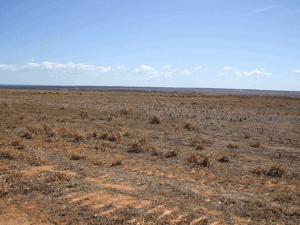
After the Harvest- Cerrado farmers are encouraged to use the no-till farming method. (Photo: Bruce Gellerman)
[MAN SPEAKING PORTUGUESE]
TRANSLATOR: Basically when you talk about the cancers, what do you see? You see people especially with cancers on their digestive systems…for example the intestines, ok. And also when you talk about malformations, at the University hospital here, we’ve been seeing lots of children with malformations like… born without legs, arms, hands. Many different malformations- no legs, no arms- even brainless.
BRUCE: You think it’s from these agro-toxins?
[MAN SPEAKING PORTUGUESE]
TRANSLATOR: You know, I’m not going to say all- 100 percent of the cases will be- but definitely a big, big, major piece of this, yes.
[VIDEO: “OWNERS OF THE WATER:” BABY CRIES, WATER SPLASHING]
GELLERMAN: Many of those cases can be found among indigenous people in the cerrado. In 2006 members of the Xavante tribe blocked a bridge –preventing soy trucks from crossing the Rio das Mortes…The River of Death.
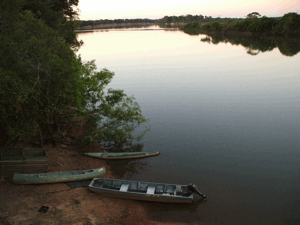
Boats on the River of Death- Members of the Xavante tribe say pesticides from soy fields are polluting their river. (Photo: Bruce Gellerman)
[CHATTING]
GELLERMAN: It was a tense, but peaceful, one-day protest… against industrial soy farmers in the area. The Xavante charge the pesticides used on soy fields were running onto tribal lands and into the River of Death. A video, “Owners of the Water” documents the demonstration…and damage to the environment.

Advertising Pesticides- The sale of pesticides in Brazil is booming. (Photo: Bobby Bascomb)
FEMALE VOICE: Women from all Xavante communities are noticing so much pollution in the river! It’s really bad. This pollution is destroying the water we use for cooking.
GELLERMAN: If the River of Death dies…say the Xavante…we all die. The Xavante aren’t the only ones protesting …in 2004 China- Brazil’s largest customer for soybeans- temporarily suspended shipments, charging they were contaminated with dangerous levels of banned pesticides.
[MONSANTO AD]
GELLERMAN: So once again, Brazilian farmers turned to agricultural science, and the promise of a new soy seed…
[MONSANTO AD]: But those who say it’s not good for the environment, I’d say we should use biotechnology even more….
GELLERMAN: Until 2004 it was illegal to sell genetically modified soybean seed in Brazil, but today, companies like Syngenta and Monsanto advertises heavily in Mato Grosso farm country. Monsanto has engineered a seed designed to grow even when dosed with their pesticide: Round Up. Monsanto calls the transgenic seed: Round Up Ready…and claims the pesticide is safe. Soy farmer Jamar Bruenier recently switched to the new biotech seed.
[MAN SPEAKING PORTUGUESE]
GELLERMAN: How does it work for you, good?
[MAN SPEAKING PORTUGUESE: MUCHO BIEN…]
TRANSLATOR: Through research we’ve done, the transgenic agriculture is going to be cleaner because we’re going to be using much less pesticides…so it’s going to be, just better… It’s going to be way less contamination in the ground and in the waters, in the water systems.
GELLERMAN: The seed will cost him more.
TRANSLATOR: But you see it will cost much cheaper because the royalties we’ll pay to Monsanto is way cheaper than what the pesticides costs.
GELLERMAN: That’s in the short term. But increasingly soy farmers are disappointed with yields from genetically modified seeds. New super-weeds that are resistant to Round Up are growing on their fields. So Monsanto has created yet another generation of biotech seed: Round up Ready 2, which can tolerate even stronger doses of pesticide.
[REBUILDING ROADS]
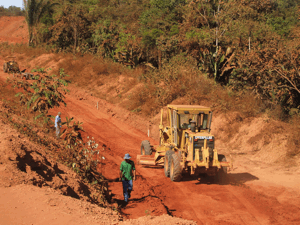
Paving a way to the Future- Mato Grosso is nearly twice the size of California but has just a handful of paved highways. (Photo: Bruce Gellerman)
GELLERMAN: A road grater repairs a soy highway washed out by torrential rains. Brazil is rapidly paving a path through the cerrado frontier to it’s future. The government recently launched ‘The Accelerated Growth Program’…to speed soy to market- it’s spending tens of billions of dollars on new roads and freight trains. China is also paying to construct a road over the Andes to take soy from the cerrado to ports on the Pacific. It’s an ambitious, audacious program that will be needed to keep pace with Brazil’s plan to increase soy production by 50 percent in the coming decade. Again, Phil Warnken of AgBrazil.
WARNKEN: Brazil has a massive, massive frontier that remains to be opened. Brazil can open more land, than the United States has under production at the current time. In the future, Brazil will be the super-power of agriculture. And, it already is right now. Brazil is the superpower of world agriculture.

Paved roads speed soy to market and open up new land for farming. (Photo: Bruce Gellerman)
[BIRDS CHIRPING]
GELLERMAN: For five centuries colonial exploiters and new world explorers came to Brazil’s cerrado searching for lost cities of gold. But, today, in the harsh frontier of Mato Grosso it’s green gold that the world seeks…fields of soybean that only seem to go on forever…in what is left of the biologically richest savanna on the planet. For Living on Earth I’m Bruce Gellerman.
[MUSIC]: Thievery Corporation “Samba Tranquile” from The Mirror Conspiracy (ESL Music 2000).
YOUNG: LOE’s Bobby Bascomb helped produce our story. For pictures and more visit our website LOE dot ORG. Coming up: we heard about the seaweed of the Sargasso – now the story of the plastics in the Sargasso trash - That’s just ahead on Living on Earth.
Related links:
- Visit AgBrazil
- Learn about Brazil’s Cerrado
- Visit Alianca da terra
- A Worldwatch Institute report on soy traders agreement to protect Amazon, but not the Cerrado
- Xavante Video-Owners of the Water
[CUTAWAY MUSIC]: Jason Moran: “Big Stuff” from Ten (Blue Note Records 2010).
Science Note/ Spud Saboteur Turns Good
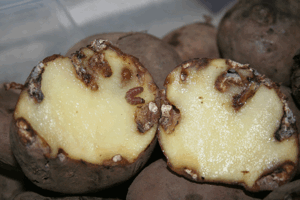
Guatemalan potato moth. (Photo: Katja Poveda)
YOUNG: It’s Living on Earth, I’m Jeff Young. Just ahead – the wide Sargasso Sea – is becoming a wide plastic pool… but first, this Note on Emerging Science from Amanda Martinez.
[THEME]
MARTINEZ: South American potato farmers may soon be able to double their yields. And all it took was a closer look at their biggest nemesis—the Guatemalan potato moth. A potato infested with moth larvae is not a pretty sight. The tiny, rust-colored caterpillars burrow their way through the tuber’s flesh, leaving a trail of brown rot in their wake.
But while the infested spud’s fate may be sealed, other uninfected potatoes on the same plant appear to grow much larger. Scientists at Cornell University believe the source of these super-spuds is the larvae’s saliva. Compounds in the saliva are thought to kick the plant’s photosynthesis into overdrive.

Guatemalan potato moth. (Photo: Katja Poveda)
The reason, researchers believe, is damage control. The infected plant sucks in additional carbon from the air, which causes it to produce more starch and bigger spuds. This, in turn, makes up for those tubers lost to the caterpillars’ voracious appetite. With an increase in yield of up to two-and-a-half times depending on how much of the plant is affected, farmers hopes are up. If the tuber-plumping compound can be isolated, farmers may soon be able to turn the potato-moth pest from a bane into a boon. And that’s this week’s Note on Emerging Science. I’m Amanda Martinez.
Related link:
Click here to read the paper published in “Ecological Applications”
The Other Oil Spill
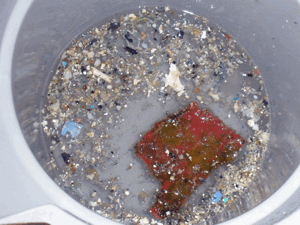
Plastic particles. (Photo: Sea Education Association—Leslie Peate)
YOUNG: The gusher in the Gulf isn't the only "oil" fouling the sea. Plastic trash, which is also petroleum-based, is plaguing the world's oceans in record amounts. Most of us have heard of the Great Pacific Garbage Patch. Its’ strange glut of plastic has been likened to a toilet that never flushes. But the North Pacific isn’t the only ocean with a plastic problem. Researchers from the Sea Education Association in Woods Hole, Massachusetts have just returned from a month-long expedition into the plastic trash of the North Atlantic. Chief scientist Giora Proskurowski is on the phone from Bermuda – where the research ship just docked – welcome to Living on Earth!
PROSKUROWSKI: Thank you, my pleasure.
YOUNG: Well, tell me about the expedition. What were you doing out there?
PROSKUROWSKI: Well, we’ve been sampling in this region from Woods Hole to Bermuda and then to the Caribbean in the western Atlantic for 25 years or so. And what we proposed to do was to go far east from Bermuda where we know that plastics exist in the ocean, and try to find the eastern boundary of this region of high concentration in the ocean. And, we were hoping to see diminishing plastic concentrations, but what we actually saw, and actually our very eastern-most surface tow, was where we found the highest concentrations of plastic that have ever been observed in any of the world’s oceans.
YOUNG: How much plastic are we talking about?
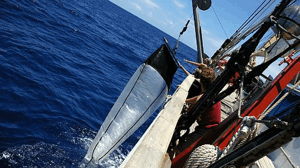
A trawling net. (Photo: Sea Education Association—David M. Lawrence)
PROSKUROWSKI: Well, so what we do typically is we put a net in the water, a surface net, that filters about 4,000 bath-tubs worth of surface water, and what we found that was in our nets that we towed for half an hour, or a nautical mile, was 23,000 pieces of plastic. And these are very small fragments, the size of, you know, a fiber, maybe a centimeter long, the thickness of a hair or a piece of just a fragment of plastic the size of a pencil eraser or smaller. And we found 23,000 of those in our net tow, which turns out to be 26 million pieces of plastic per square kilometer.
YOUNG: That’s astounding.
PROSKUROWSKI: And that’s discounting all the macro debris, the larger debris, that we saw. On that day, which was sort of a dispiriting day, although it was very exciting for our expedition, all of a sudden we got very flat water and we saw just, lots of large floating debris. And, all of a sudden our nets were in the water and we just got massive… it was like sand drifts of plastic in our sieves where we process them- it was pretty upsetting.
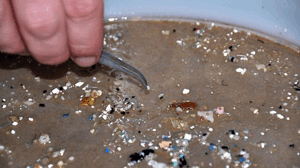
Plastic fragments. (Photo: Sea Education Association—Marilou Maglione)
YOUNG: And this is a record?
PROSKUROWSKI: I believe so. SEA’s been doing this research for 25 years and this is a hundred times more than we’ve ever got in any of our net tows. I know there was an expedition out in the Pacific last year and I think they got a million, or four million was their highest per square kilometer. So using that same metric, this was still about ten times more than what anybody’s ever seen. And, I’d always sort of thought that the Atlantic had maybe less plastic than the Pacific, and that’s typically what you hear, but from our findings on this trip, there’s really not that much difference at all.
YOUNG: Now, you’ve been in these “trash vortex areas,” as they’re sometimes called, in both the Atlantic and the Pacific. Why do these things happen where they happen?
PROSKUROWSKI: That’s a good question. It’s a very good way to learn about the Earth that we live on and it comes down to the basic simple physics that we live on a rotating, spherical body, that’s unevenly heated at the equator. So, the sun heats the water at the equator, that air rises, it becomes less dense and rises with the humidity, and what happens is it moves north or south, and it cools a little bit, and it happens to be that both 30 degrees north latitude and 30 degrees south the air starts to sink and you get these large regional areas of high atmospheric pressure and that’s what’s known as the Bermudan high- that’s why it’s really sunny out there today- and these regions of high pressure are associated with low winds and low currents.
And, so, once floating debris starts to get in the ocean they sort of drift slowly to these regions and then they stall out because of the low winds and slow currents and there’s no really forcing to get them out of this region, they just slowly accumulate.

The Sea to Education Association vessel (Photo: Sea Education Association)
YOUNG: So it’s more or less in the same spot in the Pacific as in the Atlantic when you look at where it is in relation to the equator.
PROSKUROWSKI: Yeah, exactly. So it’s 30 degrees latitude both north and south, and it’s not just the north Pacific or the north Atlantic, it’s the south Pacific and south Atlantic and the Indian Ocean as well. Anywhere where there’s a large ocean basin centered at 30 degrees you’ll get this same phenomenon.

A Neuston Tow. (Photo: Sea Education Association—Leslie Peate)
YOUNG: And, I’m wondering, when you haul up 23,000 pieces of plastic in a single scoop, more or less, what do you think about us when you’re out there looking at all that plastic? And what we’re doing to the oceans just through tiny little pieces of consumption, pieces of plastic?
PROSKUROWSKI: Yeah, the ocean’s not supposed to have any plastic, and yet we were pulling it out like we were a recycling center. It definitely forces you to confront how humans interact with the environment and how we’ve changed it. And, I think in these days of people doubting global warming because you can’t physically see it or observe it with your eyes- this is an example. And, I think that’s one reason why it resonates with so many people, is because we can be 2,500 miles from land and pull out 23,000 pieces of plastic and it is our habits of one-use consumer plastics that’s doing this.
YOUNG: Giora Proskurowski with the Sea Education Association, thanks very much!
PROSKUROWSKI: Thank you very much, it’s my pleasure to be here.
YOUNG: For pictures of plastic trash in the North Atlantic and more about Sea Education Association's expedition, go to our website, loe.org.
Related link:
Visit the expedition’s website
[MUSIC]: Sonny Sharrock “The Past Adventures Of Zydeco Honeycup” from Seize The Rainbow (Enemy Records 1987).
Self-reconfiguring Robots
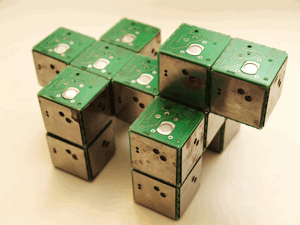
Smart modular robots are designed to change their shape and behavior. (Photo: Distributed Robotics Lab/CSAIL Center for Robotics/MIT)
YOUNG: Most machines are designed to handle one particular task, say a lawnmower, or a vacuum cleaner. But robots are “programmable” machines that can change behavior. And researchers are now developing robots that can change a lot more: their shape, their software and their hardware. Our story comes from the series: "Engineers of the New Millennium," from IEEE Spectrum Magazine and the National Science Foundation. Glenn Zorpette takes us to the MIT Lab working on, what you might call… the transformers.
ZORPETTE: Robotics Engineer Daniela Rus sees a future in which robots not only do what we want, they become what we want.
RUS: So that anybody can make whatever robot they need on demand, much like a child might make a toy out of clay, except that now we have electronic clay, where every particle of the clay has smarts and can work with other particles to make new and interesting and on demand things.
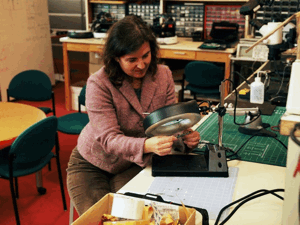
Daniela Rus is a robotics engineer at MIT’s Computer Science and Artificial Intelligence Lab. (Photo: Distributed Robotics Lab/CSAIL Center for Robotics/MIT)
ZORPETTE: Rus and her team at the Computer Science and Artificial Intelligence Lab create “self-reconfiguring robots” and “programmable matter.” Essentially, robotic systems so smart, so flexible, they can become anything. So, if robots were the size of say…Legos…what would you build?
RUS: You can tell your bag of Legos make me a boat and then disassemble and make me a plane and then disassemble and make me a horse and the Lego blocks would be able to do that without the human input.
GILPIN: OK, so, this is a demonstration of our system and what’s happening here is there are five phases in this process…
ZORPETTE Kyle Gilpin designed the lab’s first system of “programmable matter by sculpting”… it’s a collection of identical robotic cubes… each four centimeters wide… and these cubes are built and programmed to connect and communicate with each other to form things. Gilpin tells them what to do by sculpting the shape he wants on his computer.
GILPIN: So, we can say we want these modules in the structure and these modules out of the structure, and once we’ve sculpted on the computer screen the information is then transferred back to the structure, distributed within the structure, and then the modules that aren’t supposed to be a part of that goal shape break off and peel off like you’d peel the layers of an onion off, and they fall away and you’re left with the structure that you sculpted on the computer screen.

Kyle Gilpin communicates with the modular robots by computer. (Photo: Distributed Robotics Lab/CSAIL Center for Robotics/MIT)
ZORPETTE: Gilpin recently downsized his original design and the cubes are now just one centimeter wide. The smaller they make these robotic cubes, or programmable matter, the more flexible they are to create different shapes. They’re already smaller than Legos, but the goal is for them to be no bigger than a grain of sand.
GILPIN: The way that I think of this system is we have a bag of this smart sand and it’s kind of the universal tool kit, so say you’re a scientist at South Pole over the winter and there’s no way of getting supplies in and out and you need a specific tool, so you can convey that information to your bag of smart sand, shake it up, the modules in the bag bond together and unbond selectively. Once that process is done, which would be quick, you reach in, and you can grab your screw driver or wrench or whatever it is you’ve made, use that tool, when you’re done with it, you can put it back in the bag, it disintegrates and then you can repeat the process for something else.
ZORPETTE: One of the major challenges in creating self-reconfiguring robotic systems and programmable matter is finding construction materials.
RUS: If you make a couch out of these modules, it’s going to have a lot of corners. It’s not going to be very comfortable until we can really get the fabrication to produce millimeter scale objects.
ZORPETTE: Another goal is to make self-reconfiguring robots smart enough to adapt to their environment or task without human guidance.
RUS: For instance, if the robot’s mission is to travel long distance cross-country and the robot arrives in front of the tunnel, the robot should figure out that the best way to do at this point is to squeeze through the tunnel in the form of a snake.

Smart modular robots are designed to change their shape and behavior. (Photo: Distributed Robotics Lab/CSAIL Center for Robotics/MIT)
ZORPETTE: Rus says such robots could be sent into dangerous situations or remote regions of the planet to carry out missions…the sky is literally the limit.
RUS: It’s a very exciting time. I think that the age of robotics is really upon us, and I really think that robotics is the next disruptive technology, so we will see a great impact in everyday life because of advances in how we make machines and how we control them.
YOUNG: Glenn Zorpette’s story was reported by Laurie Howell, for the series: ‘Engineers of the New Millennium: Robots for Real’ a co-production of IEEE Spectrum Magazine and the Directorate of Engineering for the National Science Foundation.
Related links:
- MIT Computer Science and Artificial Intelligence Lab
- Distributed Robotics Lab at MIT
- IEEE Spectrum Magazine and the National Science Foundation series “Robots for Real”
[MUSIC]: Alice Russell/J Boogie “Got The Hunger: J Boogie’s Houston Remix” from Pot Of Gold remixes Vol. 1 (Six Degrees records 2009).
The Message Remixed

Markese "Doo Dat" Bryant has become the poster boy for environmental hip hop.
YOUNG: Since its beginnings, rap music has tackled the social issues in the cities that gave rise to the musical form. For instance - “The Message,” from Grand Master Flash and the Furious Five in 1982.
[MUSIC: Broken glass everywhere. People pissing on the stairs, you know they just don't care. I can't take the smell, I can't take the noise. Got no money to move out, I guess I got no choice.]
YOUNG: Nearly 30 years later, garbage, pollution, and unemployment are still part of rap’s message and that’s given rise to a small but growing genre of Green Hip Hop. Living on Earth and Planet Harmony's Ike Sriskandarajah reports.
[MUSIC]: Young Jeezy “My President” from the Recession (Def Jam records 2008).
SRISKANDARAJAH: Young Jeezy and Nas wrote one of the most recognizable hip-hop anthems of 2008.
SONG: My president is black my lambo’s blue and I’ll be goddamned if my rims ain’t too.
SRISKANDARAJAH: The election of president of Barack Obama is still being celebrated by hip-hop artists- now- it’s a different color getting the praise.
[MUSIC]: Doo Dat “The Dream Reborn (My President Is Green) Self Produced
SONG: My President is black, but he’s going green. My president is black, but he’s going green.
"Doo Dat" has won praise from activists, hip hop fans and even the EPA for his song, "The Dream Reborn"
SRISKANDARAJAH: Ayana Meade is an environmental writer researching the growing trend of green hip-hop.
MEADE: Yeah, it’s a small genre. You may not hear it on some of the pop radio stations in New York that play hip-hop, you know your 97.1’s or on your BET’s. But, there are a few people who, I don’t know if they exclusively rap about green issues, but they exist.
SRISKANDARAJAH: So, who do you see taking up this ‘green lantern’?
MEADE: Markese Bryant is definitely a star already. He organizes on his campus and his community teaching other young folks about green issues. And then, of course, he moonlights also as a rapper, and his stage name is DooDat, which we probably all should do, you know, DooDat- DooDat with the green movement.
[MUSIC]: Doo Dat “The Dream Reborn (My President Is Green) Self Produced.
SONG: … Doo Dat got a message for the hood. It’s time to go green, we gotta go green The food ain’t fresh and the air ain’t clean…
SRISKANDARAJAH: Markese Doo Dat Bryant, has made a name for himself as a green rapper. But he isn’t thrilled with the label.
BRYANT: Actually, actually no. I consider myself to be a rapper that just happens to be an eco-conscious individual.

Markese "Doo Dat" Bryant is seminal in the environmental hip-hop genre.
SRISKANDARAJAH: He’s an Oakland native. But his ecological awakening came while he was living in Vallejo.
BRYANT: And while I was staying in Vallejo, California, we stayed right next to a Chevron refinery. And, so, as far as the fumes, it actually contributes to the asthma rates in the community. And, I just felt that it was very important to speak on it, because a lot of us, especially in the hood, really don’t even understand where our electricity is coming from.
SONG: …In my backyard…The refinery. Something like my neighbors ain’t doin’ me no favors…. We need green jobs, we don’t need no jails…
SRISKANDARAJAH: So how is your song received by people in your community?
BRYANT: It was well received. It was very funny though, because I actually shot that video right in the hood, right on the block, everybody was excited, and then once the song started coming on, and I was talking about, ‘it’s time to go green, it’s time to go green,’ you know, I got a few looks, like, OK, what is he talking about?
SRISKANDARAJAH: Markese may draw some funny looks. But he’s hardly alone. Eco conscious songs have slowly been making headway.
[MUSIC]: Dr Octogon “Trees” from The Return Of Dr. Octogon (CMH Records 2006).
SRISKANDARAJAH: From Dr Octagon AKA Kool Keith lamenting the loss of Trees…
Dr. Octagon AKA Kool Keith mourns the loss of trees in his own strange way
SRISKANDARAJAH: To the Trunk Boiz promotion of tricked out bicycles on Scraper Bike…
[MUSIC]: Trunk Boiz “Scraper Bike” Self Produced.
SONG: …My scraper bike go hard, I don’t need no car…
Scraper bikes are the most stylish way to get around the Bay Area
SRISKANDARAJAH: And then there’s the Dead Prez fitness plan - Be Healthy
[MUSIC]: Dead Prez “Be Healthy” from Lets Get Free (Relativity 2000).
SONG: I don’t eat no meat, no dairy, no sweets, only ripe vegetables, fresh fruit and whole wheat…
SRISKANDARAJAH: These rappers and their environmentally minded tracks have won praise from fans and activist groups. The Bay Area’s Green for All and Grind for the Green and DC’s Hip Hop Caucus have started using rap as a vehicle for their green message. And, one of the most popular performers of the year, Drake, even signed on to the Green the Block tour. But environmental writer, Ayana Meade says there’s still a long way to go.
MEADE: The green rap genre is still under the underground.
SRISKANDARAJAH: So if we’re looking back at hip hop history, Chuck D calls rap music the black CNN. Do you think rappers like Markese are bringing news to their communities?
MEADE: Information about the green movement is not information that a lot of these young people in urban communities are not aware of.
[MUSIC]: Dan Mahle “A Better World” from the Green For All Song Contest.
MEADE: Hip Hop really needs to embrace the green movement, and get kids interested and engaged. I mean, look at the election of Barack Obama, look at how many kids grasped on to that because they need a movement, they need something to feel alive, I think the green movement can be that for young people today.
SRISKANDARAJAH: For Living on Earth and Planet Harmony, I’m Ike Sriskandarajah.
YOUNG: Planet Harmony welcomes all and is designed to have special appeal for young African Americans. Check out the playlist of songs in Ike’s story, and join the discussion at My Planet Harmony dot com. That's my planet harmony dot com.
Related links:
- The Hip Hop Caucus
- Green For All in Oakland use the mass appeal of music to convey their environmental messages.
- See more coverage of environmentally conscious hip hop at My Planet Harmony.
YOUNG: Living on Earth is produced by the World Media Foundation. Our crew includes Bobby Bascomb, Eileen Bolinsky, Bruce Gellerman, Ingrid Lobet, Helen Palmer, Jessica Ilyse Smith, Ike Sriskandarajah, and Mitra Taj, with help from Sarah Calkins, and Sammy Sousa. Our interns are Amanda Martinez, Meghan Miner and Ami Ninh. Jeff Turton is our technical director. Alison Lirish Dean composed our themes. Steve Curwood is our executive producer. You can find us anytime at LOE dot org – and check out our Facebook page – PRI’s living on earth. I’m Jeff Young. Thanks for listening.
ANNOUNCER: Funding for Living On Earth comes from the National Science Foundation supporting coverage of emerging science. And Stonyfield farm, organic yogurt and smoothies. Stonyfield pays its farmers not to use artificial growth hormones on their cows. Details at Stonyfield dot com. Support also comes from you, our listeners. The Ford Foundation, The Town Creek Foundation, The Oak Foundation—supporting coverage of climate change and marine issues. The Bill and Melinda Gates foundation, dedicated to the idea that all people deserve the chance at a healthy and productive life. Information at Gates foundation dot org. And Pax World Mutual Funds, integrating environmental, social, and governance factors into investment analysis and decision making. On the web at Pax world dot com. Pax World for tomorrow.
ANNOUNCER 2: PRI – Public Radio International
Living on Earth wants to hear from you!
Living on Earth
62 Calef Highway, Suite 212
Lee, NH 03861
Telephone: 617-287-4121
E-mail: comments@loe.org
Newsletter [Click here]
Donate to Living on Earth!
Living on Earth is an independent media program and relies entirely on contributions from listeners and institutions supporting public service. Please donate now to preserve an independent environmental voice.
NewsletterLiving on Earth offers a weekly delivery of the show's rundown to your mailbox. Sign up for our newsletter today!
 Sailors For The Sea: Be the change you want to sea.
Sailors For The Sea: Be the change you want to sea.
 The Grantham Foundation for the Protection of the Environment: Committed to protecting and improving the health of the global environment.
The Grantham Foundation for the Protection of the Environment: Committed to protecting and improving the health of the global environment.
 Contribute to Living on Earth and receive, as our gift to you, an archival print of one of Mark Seth Lender's extraordinary wildlife photographs. Follow the link to see Mark's current collection of photographs.
Contribute to Living on Earth and receive, as our gift to you, an archival print of one of Mark Seth Lender's extraordinary wildlife photographs. Follow the link to see Mark's current collection of photographs.
 Buy a signed copy of Mark Seth Lender's book Smeagull the Seagull & support Living on Earth
Buy a signed copy of Mark Seth Lender's book Smeagull the Seagull & support Living on Earth

